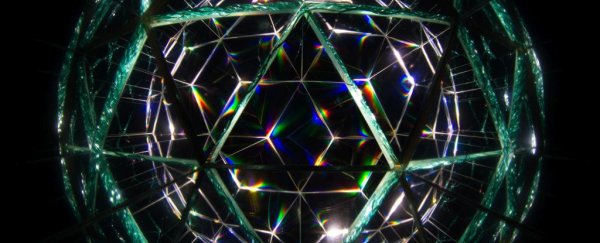Physicists have just taken an amazing step towards quantum devices that sound like something out of science fiction.
For the first time, isolated groups of particles behaving like bizarre states of matter known as time crystals have been linked into a single, evolving system that could be incredibly useful in quantum computing.
Following the first observation of the interaction between two time crystals, detailed in a paper two years ago, this is the next step towards potentially harnessing time crystals for practical purposes, such as quantum information processing.
Time crystals, only officially discovered and confirmed a few years ago in 2016, were once thought to be physically impossible. They are a phase of matter very similar to normal crystals, but for one additional, peculiar, and very special property.
In regular crystals, the atoms are arranged in a fixed, three-dimensional grid structure, like the atomic lattice of a diamond or quartz crystal. These repeating lattices can differ in configuration, but any movement they exhibit comes exclusively from external pushes.
In time crystals, the atoms behave a bit differently. They exhibit patterns of movement in time that can't be so easily explained by an external push or shove. These oscillations – referred to as 'ticking' – are locked to a regular and particular frequency.
Theoretically, time crystals tick at their lowest possible energy state – known as the ground state – and are therefore stable and coherent over long periods of time. So, where the structure of regular crystals repeats in space, in time crystals it repeats in space and time, thus exhibiting perpetual ground state motion.
"Everybody knows that perpetual motion machines are impossible," says physicist and lead author Samuli Autti of Lancaster University in the UK.
"However, in quantum physics perpetual motion is okay as long as we keep our eyes closed. By sneaking through this crack we can make time crystals."
The time crystals the team have been working with consist of quasiparticles called magnons. Magnons are not true particles, but consist of a collective excitation of the spin of electrons, like a wave that propagates through a lattice of spins.
Magnons emerge when helium-3 – a stable isotope of helium with two protons but just one neutron – is cooled to within one ten thousandth of a degree of absolute zero. This creates what is called a B-phase superfluid, a zero-viscosity fluid with low pressure.
In this medium, time crystals formed as spatially distinct Bose-Einstein condensates, each consisting of a trillion magnon quasiparticles.
A Bose-Einstein condensate is formed from bosons cooled to just a fraction above absolute zero (but not reaching absolute zero, at which point atoms stop moving).
This causes them to sink to their lowest-energy state, moving extremely slowly, and coming together close enough to overlap, producing a high density cloud of atoms that acts like one 'super atom' or matter wave.
When the two time crystals were allowed to touch each other, they exchanged magnons. This exchange influenced the oscillation of each of the time crystals, creating a single system with an option of functioning in two, discrete states.
In quantum physics, objects that can have more than one state exist in a mix of those states before they've been pinned down by a clear measurement. So having a time crystal operating in a two-state system provides rich new pickings as a basis for quantum-based technologies.
Time crystals are a fair way from being deployed as qubits, as there are a significant number of hurdles to solve first. But the pieces are starting to fall into place.
Earlier this year, a different team of physicists announced that they had successfully created room temperature time crystals that don't need to be isolated from their ambient surroundings.
More sophisticated interactions between time crystals, and the fine control thereof, will need to be developed further, as will observing interacting time crystals without the need for cooled superfluids. But scientists are optimistic.
"It turns out putting two of them together works beautifully, even if time crystals should not exist in the first place," Autti says. "And we already know they also exist at room temperature."
The research has been published in Nature Communications.
